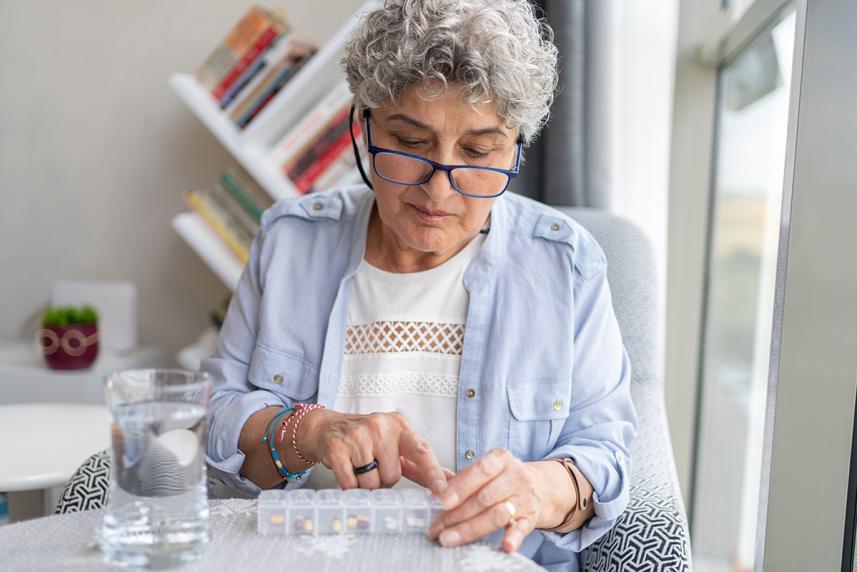
Find out if you qualify for an Aetna® Dual Eligible Special Needs Plan — we’re ready to help!
Whether you sometimes struggle to remember a dose or just have trouble getting pills down, we have advice that can help you stay on track with your treatment

With so many things to remember from day to day — birthdays, doctor appointments, bill due dates — it’s no wonder we sometimes slip up and forget to take our medicines. In fact, medication adherence, which means taking your meds as prescribed, is a big issue in the United States. About one in five patients never fill their prescriptions.* And even when they do, about half the time they’re not taken correctly.
“There are a host of reasons why many people, especially older adults, struggle to stick with their medication regimen,” says Michael Hochman, MD. He’s an associate professor of clinical medicine at Keck Medicine of USC. “The reasons range from cost to fear of side effects to just not understanding why they’re needed.”
But if you don’t take your medications correctly, you’re putting your health at serious risk. An estimated 125,000 deaths in the U.S. each year are due to poor medication adherence.* If you have a chronic illness and don’t take your medications like you are supposed to, your risk of hospital admission increases as much as 69 percent.*

Find out if you qualify for an Aetna® Dual Eligible Special Needs Plan — we’re ready to help!
If you do struggle to take your medications, it’s important to be honest with your doctor. Don’t worry that they will judge or scold you — it’s a common problem, says Dr. Hochman. But if you’re not honest, you and your doctor can’t work together to come up with solutions. Here are six possible ones to try.
Two-thirds of older adults rely on at least two prescription drugs, according to a 2020 poll.* “We know that the more drugs older adults take, the lower their medication adherence,” says Dr. Hochman.
However, up to 60 percent of drugs prescribed to older adults may not be necessary.* That’s why it makes sense to find out whether you really need to keep taking all your current medications, or if something might have changed. For instance, maybe your health has improved enough to stop taking a drug. Or perhaps one of your medications is doing the job of two.
To find out more about your medications, ask your care team about the Medication Therapy Management program. This program helps you and your doctor manage your medications. If you qualify for the program, a pharmacist will do what’s called a “brown bag” medicine review. That’s when they review all your medicines to make sure you’re taking the right ones at the correct dosages. During the review, you can go through each one and talk about any questions or concerns you have.
Almost 30 percent of Americans report that they haven’t taken a medication as prescribed at some point because of cost.* If you’re struggling to pay, start by checking the cost of your medications. You can look them up in your health plan's formulary, also called a drug list.
Your formulary will tell you which tier your medication is in. Or you can check your Evidence of Coverage (EOC). In general, the lower the tier, the less you pay. Once you know the tier and price, talk to your doctor about the best, lowest-cost prescriptions for you. There may be a cheaper alternative in a different tier.
Also, if you are taking any of your medications long-term, think about getting a 100-day supply. This can save you money as well as time, since you only refill your prescription once every three months.
Need health and wellness supplies? Aetna® Special Needs Plan (SNP) members get a monthly allowance on an Extra Benefits Card to help pay for certain everyday expenses including over-the-counter (OTC) products like pain reliever and cold and allergy medicine. Schedule a call to learn more about the benefits of being an Aetna SNP member.
“Side effects — either fear of them, or actually experiencing them — is one of the biggest reasons my patients stop taking their medications,” says Dr. Hochman. If you are having drug-related side effects, your doctor may be able to change the dose. Or they can switch you to a different class of medications to solve the problem.
But sometimes what seems like a side effect, like headaches or weight gain, isn’t related to the medication, Dr. Hochman adds. “It’s always important to talk to your physician. They will be able to connect the dots — and find potential solutions — more easily than you can.”
There are plenty of smart phone apps and gadgets that can help you remember to take your meds. But a simple medication chart tacked to your fridge often does the trick, says Hochman. Write on the chart when to take each medication (say, morning or at night), the dose and a quick reason why you are taking it.
“I find the reason is particularly helpful for people who are taking medications for something that may not actually cause symptoms, such as high blood pressure or cholesterol,” says Dr. Hochman. “It reminds them that even though they feel fine now, these drugs are to keep them healthy and prevent health issues down the road.”
The U.S. Food and Drug Administration recommends that you use an organizer for all your medicines. Some have sections for multiple doses at different times of day (such as morning or evening). Some even have timer functions, so they can remind you to take a dose.
It’s also a good idea to place pill organizers in a visible spot to jog your memory when you see it. Think about timing, too. If you need to take a drug with food, place it on the dinner table or TV tray. For those that you need to take in the morning, put them next to your toothbrush, or in the kitchen beside the coffee pot.
If taking pills is not your favorite, you’re not alone. Up to 40 percent of all adults find it hard to swallow pills.* It can be especially hard if you have a condition that can affect your ability to swallow, like dementia or a stroke. One trick is taking a pill in applesauce or yogurt. The added texture can make it easier for you to swallow, says Hochman.
If that’s not working, ask your pharmacist or doctor if you can crush the pill or split it to make it smaller and easier to wash down. (It’s important to never crush a pill without asking your provider first. If the medication is extended release, you may get too much of the medication at once.)
Another option is to take a liquid version, if it’s available. If it’s an over-the-counter (OTC) medication, you might try the children’s version. Just be sure to talk about it with your pharmacist beforehand. They can help you figure out the conversion dose.
If you qualify for both Medicare and Medicaid, you may be eligible for an Aetna® Dual-Eligible Special Needs Plan (D-SNP).
You may be eligible for an Institutional Special Needs Plan if you’ve lived (or plan to live) in a participating facility for 90+ days and you have Medicare Part A (hospital insurance) and Part B (medical insurance).
If you're 65 or older and have an eligible chronic condition, you may qualify for an Aetna® Chronic Condition Special Needs Plan (C-SNP). CSNPs are currently available in select counties within IL and PA.
*FOR PRESCRIPTIONS AT A PHARMACY SOURCE: Centers for Disease Control. CDC grand rounds: improving medication adherence for chronic disease management — innovations and opportunities. Morbidity and Mortality Weekly Report (MMWR). November 2017. Accessed July 5, 2023.
*FOR MEDICATION ADHERENCE SOURCE: Kleinsinger F. The unmet challenge of medication adherence. The Permanente Journal. July 2018; 22: 18-033.
*FOR HOSPITAL ADMISSION SOURCE: Centers for Disease Control. Overcoming Barriers to Medication Adherence for Chronic Diseases. Public Health Grand Rounds. February 2017. Accessed July 5, 2023.
*FOR 2020 POLL SOURCE: Coe A, Farris K, Malani P. University of Michigan Institute for Healthcare Policy and Innovation. Clashing medications can put older adults at risk, but many haven’t had a pharmacist check for safety concerns. October 7, 2020. Accessed July 5, 2023.
*FOR 60 PERCENT OF DRUGS SOURCE: Rahman S, Singh K, Dhingra S, et al. The double burden of the COVID-19 pandemic and polypharmacy on geriatric population — public health implications. Therapeutics and Clinical Risk Management. October 2020; 16: 1007-1022.
*FOR 30 PERCENT OF AMERICANS SOURCE: Kirzinger A, Lopes L, Wu B, et al. Kaiser Family Foundation. KFF health tracking poll — February 2019: prescription drugs. March 1, 2019. Accessed July 5, 2023.
*FOR 40 PERCENT OF ADULTS SOURCE: Forough AS, Lau ETL, Steadman KJ, et al. A spoonful of sugar helps the medicine go down? A review of strategies for making pills easier to swallow. Patient Preference and Adherence. July 2018; 12: 1337-1346.
This material is for informational purposes only and is not medical advice. Health information programs provide general health information and are not a substitute for diagnosis or treatment by a physician or other health care professional. Contact a health care professional with any questions or concerns about specific health care needs. Providers are independent contractors and are not agents of Aetna. Provider participation may change without notice. Aetna is not a provider of health care services and, therefore, cannot guarantee any results or outcomes. The availability of any particular provider cannot be guaranteed and is subject to change.
Information is believed to be accurate as of the production date; however, it is subject to change. For more information about Aetna plans, refer to our website. If your plan’s Extra Benefits Card includes roll-over, any unused amount will rollover into the next month. The monthly amount can be rolled over through the end of the plan year but will not carry over into the next plan year.
The benefits mentioned are part of special supplemental program for the chronically ill. Eligibility is determined by whether you have a chronic condition associated with this benefit. Standards may vary for each benefit. Conditions include Hypertension, Hyperlipidemia, Diabetes, Cardiovascular Disorders, Cancer. Other eligible conditions may apply. Contact us to confirm your eligibility for these benefits.
Eligibility for the Model Benefit or Reward and Incentive (RI) Programs under the Value-Based Insurance Design (VBID) Model is not assured and will be determined by Aetna after enrollment, based on relevant criteria (e.g., clinical diagnoses, eligibility criteria, participation in a disease state management program). his material is for informational purposes only and is not medical advice.
Health information programs provide general health information and are not a substitute for diagnosis or treatment by a physician or other health care professional. Contact a health care professional with any questions or concerns about specific health care needs. Providers are independent contractors and are not agents of Aetna. Provider participation may change without notice. Aetna is not a provider of health care services and, therefore, cannot guarantee any results or outcomes. The availability of any particular provider cannot be guaranteed and is subject to change. Information is believed to be accurate as of the production date; however, it is subject to change. For more information about Aetna plans, refer to our website.
This is an article available on a public website, therefore there is a possibility that this article could be viewed by consumers whose benefits are SSBCI or VBID. With that, we have included both the VBID disclaimer and SSBCI disclaimer.
Nondiscrimination notice | CA-specific Nondiscrimination notice
©2025 Aetna Inc.
Y0001_3721074_2025_M
3891507-07-01
Call us at 1-833-228-1297 (TTY: 711) between 8 AM and 8 PM, Monday through Friday. Or visit AetnaMedicare.com/YourDSNP anytime.